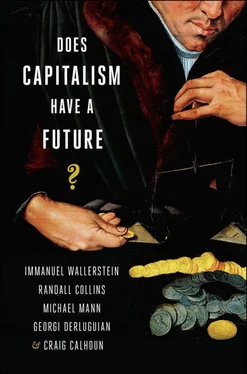Immanuel Wallerstein - Does Capitalism Have a Future?
Здесь есть возможность читать онлайн «Immanuel Wallerstein - Does Capitalism Have a Future?» весь текст электронной книги совершенно бесплатно (целиком полную версию без сокращений). В некоторых случаях можно слушать аудио, скачать через торрент в формате fb2 и присутствует краткое содержание. Город: New York, Год выпуска: 2013, ISBN: 2013, Издательство: Oxford University Press, Жанр: Публицистика, sci_economy, на английском языке. Описание произведения, (предисловие) а так же отзывы посетителей доступны на портале библиотеки ЛибКат.
- Название:Does Capitalism Have a Future?
- Автор:
- Издательство:Oxford University Press
- Жанр:
- Год:2013
- Город:New York
- ISBN:978-0-19-933084-3
- Рейтинг книги:5 / 5. Голосов: 1
-
Избранное:Добавить в избранное
- Отзывы:
-
Ваша оценка:
- 100
- 1
- 2
- 3
- 4
- 5
Does Capitalism Have a Future?: краткое содержание, описание и аннотация
Предлагаем к чтению аннотацию, описание, краткое содержание или предисловие (зависит от того, что написал сам автор книги «Does Capitalism Have a Future?»). Если вы не нашли необходимую информацию о книге — напишите в комментариях, мы постараемся отыскать её.
Does Capitalism Have a Future? — читать онлайн бесплатно полную книгу (весь текст) целиком
Ниже представлен текст книги, разбитый по страницам. Система сохранения места последней прочитанной страницы, позволяет с удобством читать онлайн бесплатно книгу «Does Capitalism Have a Future?», без необходимости каждый раз заново искать на чём Вы остановились. Поставьте закладку, и сможете в любой момент перейти на страницу, на которой закончили чтение.
Интервал:
Закладка:
The future world run by computers will not necessarily be that depicted by George Orwell in Nineteen Eighty-Four , where high tech is used for surveillance and autocratic state control. Orwell missed the economic dimension: how electronic high technology affects not just politics but employment. Similarly with the benign version of the future depicted in space age adventure films, the question of who owns the robots and computers never comes up. In the real world, the answer is: the big computer systems will be (and are) owned by big capitalist property-holders. The manufacture of IT hardware as well as software is capitalist enterprise. The popular communications companies (Facebook, Google, Amazon, Twitter, and whatever their names will be over the coming decades) show the same pattern as the historical development of any other form of capitalist enterprise: rapid innovation chained to other innovations, proliferation of competitors, winnowing out of many through the growth of a few, enthusiastic investment by financial markets, then financial pressure and collapse of former front-runners. Consolidation into oligopoly in the IT era happens just as it did in previous waves of new technology. Since the IT period is still quite new, it isn’t yet clear whether the pace toward oligopoly is different than in the era of the railroads or the era of the automobile industry; so far it looks like the current speed toward oligopoly is much faster than in previous periods. (This is a side question from the main issue of technological displacement of the middle class; as long as that goes on, whether there is a high degree of oligopoly or not does not much affect the long-term crisis of capitalism.)
But, one might object, Information Technology is different. Computerization is not just something that happens to big companies and big employers; it is something that ordinary people use and enjoy. Computers are not owned just by the capitalists; they are owned by all of us. That is like saying (in 1925 or 1955): automobiles are not capitalist industries; since I own one myself, I have the freedom to drive all over, escape, get laid in the back seat, drag-race on the highway if I want to. Enthusiasm for products of capitalist industry is part of what makes capitalism successful. That’s fine; enjoy it while you can. The fact that you can hear portable music at any time and place, post and view images and texts and all the other things that consumer IT devices enable contemporary consumers to do—all this says nothing about whether or not there are jobs for persons like yourself. The popularity of automobiles was not just consumer enjoyment; it reflected an industry which, for several decades, generated a large number of well-paying jobs. Subsequently, technological displacement and capitalist consolidation have drastically reduced jobs in the automotive sector. All the personal electronic devices of today that absorb people’s attention and enthusiasm will not fend off capitalist crisis, if these same consumers cannot find jobs. Eventually they will not be able to buy these devices, nor their producers to sell them. That is the shape of deep, structural capitalist crisis.
ESCAPE NUMBER 2: GEOGRAPHICAL SPREAD OF MARKETS
We tend to think of market spread as globalization, but globalization is only a quantitative difference in degree, not a qualitative difference in kind. Even within the confines of state borders, markets have grown by spreading to regions where a product was initially unknown; thus local conditions favored profit for the innovator coming from elsewhere. Geographical spread works in tandem with product innovation, keeping up the ongoing existence of market frontiers. Dynamic markets always have the buzz of newness, the cultural prestige of being a center or keeping up with a center, or the negative prestige of striving to escape from backwardness. The liberal version of this mechanism, on the global or interstate scale, is modernization theory or development theory; each part of the world successively ascends the stages, until presumably all will be fully developed, tertiary-sector service economies. We are now seeing this come into being, the argument goes, in India and China, the big nations of the Third World making their way inexorably to modernity.
The Neo-Marxist version of this process is World-System theory [Arrighi 1994; Chase-Dunn 1989; Wallerstein 1974–2011]. This is a less benign version of the geographical spread of capitalist markets; world market domination is buttressed by military power and political influence; the hegemonic center exploits the labor or raw materials of the periphery, with the aid of a transmission belt of semiperipheral regions. World-system theory complicates the pattern by a succession of hegemonies marked by major wars, and keyed to long Kondratieff waves of relative expansion and stagnation in world markets. But these cycles of serial hegemons—Spain, Holland, Britain, the United States, conjecturally China—logically come to an end when the periphery is exhausted, and every region of the globe is fully brought into the capitalist market. There are no more safety-valves, no more regions for exploitation; capitalist profit dries up.
Leaving aside the specific merits of world-system theory predictions, the point I would emphasize is that globalization of markets is now undercutting middle-class jobs. Internet technology makes it possible for white-collar workers in India—or anywhere else—to compete for jobs in servicing computerized businesses in the core capitalist regions of the world. Whereas in the past middle-class workers have been protected from competition to a greater degree than manual workers, this is no longer true; the Internet creates a much wider pool of workers who can access available jobs, especially if they do not have to physically move to a distant place of work. Contemporary globalization also involves much more rapid international travel. Managerial and professional workers physically move their expertise and their negotiating skills to entrepreneurial sites around the globe; this has the further effect of homogenizing upper-middle-class labor into a single labor market, raising the prospects of cheapening management costs, and displacing even high-level technocratic labor. Greater connectedness leads to greater competition for jobs, undercutting middle-class salaries. This process is relatively recent; the jet-set boom of the upper-middle class in recent decades is becoming vulnerable to the same structural displacement that the cost-cutting experts have visited upon their employees. High-level professional and technical specialists face a much more competitive and uncertain existence than ever before, when they were protected by national enclaves.
In the past, international migration provided cheap labor for centers of manufacturing, and more recently for the lower levels of the advanced service economies, thereby undercutting the working class of wealthier nations. Now as communications technology tends to spread cultural capital more homogeneously around the globe, it is middle-and upper-middle-class labor that is being undercut.
ESCAPE NUMBER 3: META-MARKETS IN FINANCE
If working-class and then middle-class labor are technologically displaced, can the slack be taken up by everyone becoming a capitalist? This argument has been advanced as employee pension funds have come to play a large role in financial markets, and as financial services firms have expanded and have aggressively marketed investments to a larger constituency. In countries like the United States, where home ownership is widespread, the inflation of housing prices brought opportunities not only to treat home ownership as a speculative investment, but to withdraw equity from inflated housing prices in the form of cash for consumer spending. These financial practices have been among the short-term sources of the recent economic crisis and especially the financial meltdown of 2008.
Читать дальшеИнтервал:
Закладка:
Похожие книги на «Does Capitalism Have a Future?»
Представляем Вашему вниманию похожие книги на «Does Capitalism Have a Future?» списком для выбора. Мы отобрали схожую по названию и смыслу литературу в надежде предоставить читателям больше вариантов отыскать новые, интересные, ещё непрочитанные произведения.
Обсуждение, отзывы о книге «Does Capitalism Have a Future?» и просто собственные мнения читателей. Оставьте ваши комментарии, напишите, что Вы думаете о произведении, его смысле или главных героях. Укажите что конкретно понравилось, а что нет, и почему Вы так считаете.












